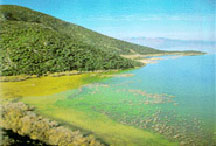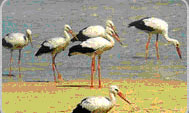Ichkeul National Park is located in northern Tunisia about 15km south of the Mediterranean. The Park consists of a wooded massif and a lake of brackish water. The lake is connected to the sea by the river Oued Tindja. The Park comprises approximately 1,360ha of mountain terrain; 8,500 ha of lake and the rest of the Park’s area is marshland.
Lake Ichkeul is the last of a chain of lakes which used to extend across the North African seaboard and one of the four most important and productive remaining wetlands in the western Mediterranean. It is a major stopover for hundreds of thousands of migrating birds; over 300,000 birds can be present at one time at the lake. Geese, storks and pink flamingoes come to feed and nest there. The threatened migrant white stork and 4% of known world population of the white-headed duck, 226 species of birds, the rare black stork and glossy ibis have all been recorded here.
The resident and the migratory birds are attracted by the wide range of plant habitats within the park; the mountain is dominated by wild olive trees and dense shrubs. Grasses grow in the marsh pools and in drier areas and ridges are oleander and lotus.
One of the most notable mammals at Ichkeul is the otter which has been hunted for its meat and is threatened with extinction. There are large populations of wild boar, and wild water buffalo, porcupine, jackal, Egyptian mongoose, wildcat, and four species of bats.
The amphibians vary with water level and salinity. The marsh frog, the painted frog, three species of toad, two harmless species of snake and two pond turtles are found in the lake.
The lake’s fish are eel, mullets, sole, sea bass, barbel, shad , anchovy, Mediterranean killifish and seahorse.
The lake, marshes and mountain have been settled for centuries. In 1740 Jebel Ichkeul and the lake were managed as a hunting reserve. Water buffalo were introduced from Italy in 1729.
The lake is fed by six main rivers from the west and south: Oueds Douimis, Sejenane, Malah, Rhezala, Joumine, and Tine. The rivers dry out in summer. The lake’s salinity began to increase in the mid 90s after dams were constructed on some of these rivers almost cutting off the fresh water supply.
The fresh-water reeds and grasses have been replaced by salt tolerant grasses. The migratory birds depended on the former habitat; and so species such as purple heron, purple gallinule and reed warblers have disappeared from the park.
In 1996 the Park was inscribed on the List of World Heritage Sites in Danger. In 1998 the World Heritage Committee recommended sending an expert mission to the site “to look into possibilities of developing measures to retain freshwater and reduce the salinity of the lake.”
sources: http://www.unesco.org/whc/sites/8.htm , http://www.ramsar.org/ram/ram_rpt_41e.htm http://www.wcmc.org.uk/protected_areas/data/wh/ichkeul.html





